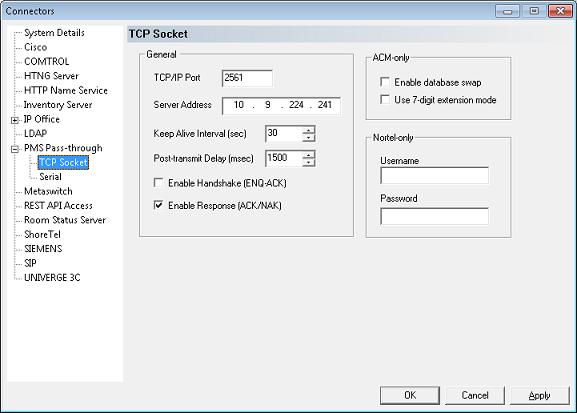|
The TCP socket settings are used when the PMS Pass-through feature is configured to use a TCP socket connection.

General
These settings may apply to any supported PBX. Changes to any of these settings will require a system restart to take effect.
Setting
|
Description
|
TCP/IP Port
|
Set this value to the port number that the PBX expects to use for communication with the DV2000/DV4.
For Nortel over TCP, this must be set to 513.
|
Server Address
|
Enter the IP address of the PBX.
For Avaya ACM, this field can be left blank since the DV2000/DV4 is hosting the connection.
|
Keep Alive Interval (sec)
|
Enter the time in seconds for the keep alive (polling) interval. A keep alive will be sent whenever there has been activity on the link for the specified interval.
Choose a time that is less than the maximum amount of time the PBX allows the link to be idle. For example, the ACM by default expects to receive a keep alive within 20 seconds of the last communication activity. In this case, the default value of 15 seconds is sufficient. If the PBX does care how long the link is idle, you can choose a longer interval, such as 60 seconds.
This setting is only used if the communication protocol supports a keep alive or polling packet type.
|
Post-transmit Delay (msec)
|
Enter the number of milliseconds the system should wait after it sends a packet to the PBX (and receives an ACK in return) before it can send another packet.
This is to keep the VMS from sending data to the PBX too quickly.
The default value is 1500 ms (i.e., one and a half seconds).
|
Enable Handshake (ENQ-ACK)
|
Check this box if the PBX requires the VMS to send an ENQ byte and receive back an ACK byte before sending a packet to the PBX.
This option is required for Avaya ACM, and often for Mitel as well.
|
Enable Response (ACK-NAK)
|
Leave this box checked (enabled) unless the PBX type is Aeonix.
The FIAS protocol used by Aeonix dispenses with ACK/NAK responses when sending data over a TCP/IP link. However, all other supported PBX systems typically do require ACK/NAK responses, so this option should always be enabled except when the PBX is Aeonix.
|
ACM-only
The following settings only apply when connecting to an Avaya ACM PBX.
Setting
|
Description
|
Enable database swap
|
Check this box to enable the VMS to send a full database swap whenever the ACM requests it.
If not checked, the VMS will only send a Swap Start packet followed immediately by a Swap End packet.
|
Use 7-digit extension mode
|
Check this box to enable support for extension numbers up to 7 digits in length (default is 5 digits).
By default, the ACM protocol limits extension numbers to a maximum length of 5 digits. However, some versions of the ACM may be capable of being configured to allow up to 7 digits.
7-digit support must be configured on both systems, or disabled on both systems, or they will not be able to communicate correctly with each other.
|
Nortel-only
The following settings only apply when connecting to a Nortel PBX over TCP/IP. Nortel uses the RLogin protocol when connecting over TCP/IP and therefore requires an account user name and password.
Setting
|
Description
|
Username
|
Enter the user name required to log onto the Nortel PBX.
|
Password
|
Enter the password required to log onto the Nortel PBX.
|
|





